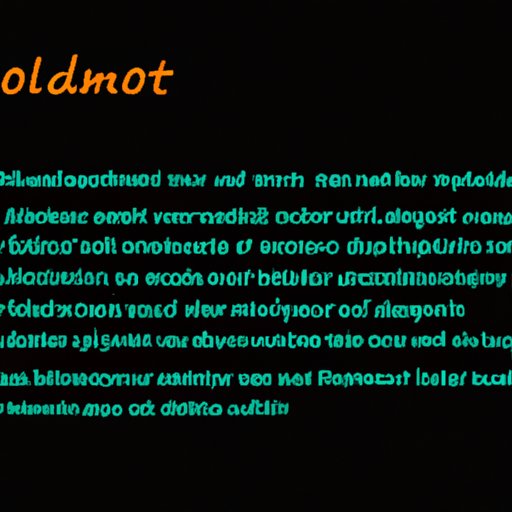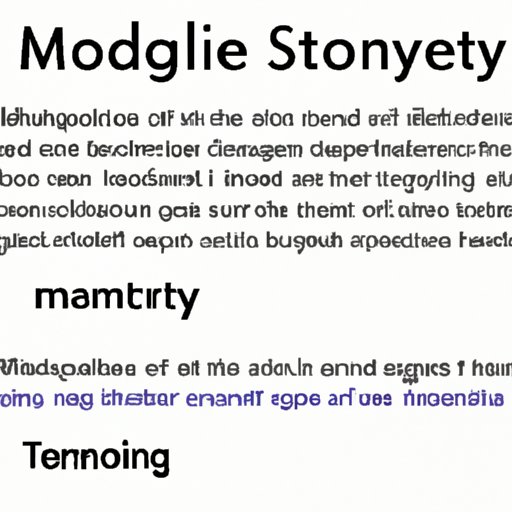Introduction
Writing modes are the various ways in which a writer can communicate with an audience. They are used to convey information, express opinions, and tell stories. Knowing how to use different writing modes can help writers communicate more effectively and engage readers.
The definition of writing modes is broad and encompasses a variety of approaches including narrative, descriptive, expository, and persuasive. Each mode has its own purpose and can be used in a variety of contexts. Understanding the advantages of each mode and how to use them effectively can help writers create compelling content.
Types of Writing Modes
The four main writing modes are narrative, descriptive, expository, and persuasive. Each type of writing serves a different purpose and has its own unique elements.
Narrative
Narrative writing tells a story. It is often used in fiction, but it can also be used in non-fiction. In narrative writing, the writer creates characters, settings, and plots that draw the reader into the story.
Descriptive
Descriptive writing paints a vivid picture of a person, place, or thing. The goal of descriptive writing is to make the reader feel as if they are part of the scene being described. Descriptive writing uses sensory details, metaphors, and other literary devices to bring the subject to life.
Expository
Expository writing provides information about a topic. It is often used in academic or business contexts to explain complex topics in a clear and concise manner. Expository writing should be objective and logical, and it should use facts and evidence to support its claims.
Persuasive
Persuasive writing is used to convince the reader to take a certain action or adopt a particular point of view. Persuasive writing should be rooted in facts and evidence, but it should also include emotional appeals and logical arguments to sway the reader to the writer’s position.

Choosing the Best Writing Mode for Your Project
When choosing the best writing mode for your project, there are several factors to consider. Analyzing your goals, understanding your audience, and examining the topic can all help you determine which writing mode is most appropriate for your project.
Analyzing Your Goals
The first step in choosing a writing mode is to analyze your goals. Ask yourself what you want to accomplish with your writing. Are you trying to inform, entertain, or persuade? Understanding your goals will help you determine which writing mode is best suited for your project.
Understanding Your Audience
Another factor to consider when selecting a writing mode is your audience. Who are you writing for? Different audiences respond differently to different writing modes. Understanding who your audience is and what they expect will help you determine the best writing mode for your project.
Examining the Topic
Finally, it is important to examine the topic of your project when selecting a writing mode. Different topics require different writing modes. For example, a scientific paper would be best written in an expository style, while a creative short story would be better suited to a narrative style.
Structures of Writing Modes
Each writing mode has its own structure that must be followed in order to be effective. While some elements may overlap, each writing mode has its own unique structure.
Narrative
Narrative writing typically follows the classic five-paragraph structure. It begins with an introduction that introduces the characters and setting of the story. The body of the story contains the rising action, climax, and resolution. The conclusion wraps up the story and ties together loose ends.
Descriptive
Descriptive writing does not have a set structure. However, it should begin with an introduction that sets the scene and establishes the tone. The body of the text should contain vivid descriptions of the subject using sensory language, metaphors, and other literary devices. The conclusion should summarize the main points and leave the reader with a lasting impression.
Expository
Expository writing typically follows the five-paragraph structure. The introduction should provide background information on the topic and state the thesis. The body paragraphs should contain evidence and examples to support the thesis. The conclusion should summarize the main points and reiterate the thesis.
Persuasive
Persuasive writing also follows the five-paragraph structure. The introduction should introduce the topic and establish the writer’s position. The body paragraphs should contain evidence and arguments to support the position. The conclusion should restate the thesis and call the reader to action.

Role of Writing Modes in Education
Writing modes play an important role in education. They can help students improve their writing skills, develop critical thinking, and enhance communication. Knowing how to effectively use different writing modes can help students become more successful in school and beyond.
Improving Writing Skills
Learning how to use different writing modes can help students improve their writing skills. Students can practice using different writing modes to become more proficient in each one. This will help them become better communicators and more confident writers.
Developing Critical Thinking
Writing modes can also help students develop critical thinking skills. When students are asked to write in different modes, they must think critically about the topic and consider different perspectives. This helps them become more informed and open-minded thinkers.
Enhancing Communication
Using writing modes can also help students enhance their communication skills. Learning how to effectively use different writing modes will help students communicate more clearly and effectively. This can be beneficial in both academic and professional contexts.
Impact of Writing Modes on Communication
Writing modes can have a positive impact on communication. Knowing how to use different writing modes can help writers clarify their ideas, connect with an audience, and engage with a reader.
Clarifying Ideas
Writing modes can help writers clarify their ideas. By using the appropriate writing mode, writers can ensure that their message is communicated clearly and effectively. This can help readers understand complex topics and make informed decisions.
Connecting with an Audience
Writing modes can also help writers connect with their audience. Different audiences respond to different writing modes. Understanding which writing mode is best suited for a particular audience can help writers create content that resonates with them.
Engaging with a Reader
Finally, writing modes can help writers engage with a reader. Knowing how to use different writing modes can help writers create content that is interesting and engaging. This can help keep readers interested and motivated to continue reading.

Effectiveness of Writing Modes in Storytelling
Writing modes can also be effective tools for storytelling. Knowing how to use different writing modes can help writers create suspense, establish tone, and craft characters.
Creating Suspense
Using narrative writing can help writers create suspense in their stories. By using cliffhangers and foreshadowing, writers can keep readers guessing and build anticipation for what is to come.
Establishing Tone
Writing modes can also help writers establish the tone of a story. Using descriptive writing, writers can create a mood and evoke emotions in their readers. This can help make the story more powerful and impactful.
Crafting Characters
Finally, writing modes can help writers craft memorable characters. By using narrative writing, writers can create dynamic characters with distinct personalities and backstories. This can help make the story more engaging and relatable.
Conclusion
Writing modes are an important tool for communicating ideas effectively. Each writing mode serves a different purpose and has its own unique elements. Knowing how to use different writing modes can help writers create compelling content and engage readers. Writing modes can also be effective tools for storytelling, helping writers create suspense, establish tone, and craft characters. Understanding the advantages of each writing mode and how to use them effectively can help writers communicate more effectively.
(Note: Is this article not meeting your expectations? Do you have knowledge or insights to share? Unlock new opportunities and expand your reach by joining our authors team. Click Registration to join us and share your expertise with our readers.)
